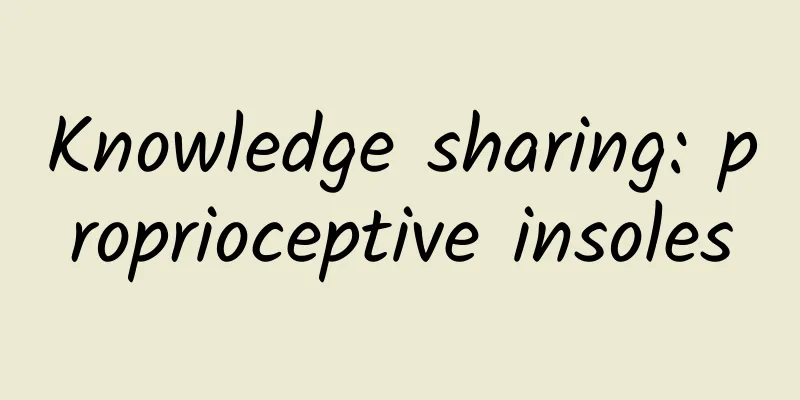Knowledge sharing: proprioceptive insoles

|
Proprioceptive insoles The proprioceptors of muscles, tendons, ligaments and joints are very sensitive to pressure and changes in muscle and joint shape, allowing us to feel the position and movement of the body. This feeling is called proprioception . The superficial and deep proprioceptive organs that affect the nervous and motor systems mainly include the human skin, muscle tension, muscle length, tendons, etc. Proprioceptive insoles stimulate the attachment points of the plantar muscles and tendons . These stimulating elements not only increase muscle tension but also reduce excessive muscle tension through external pressure stimulation. It has the function of improving the motor activity of the corresponding stimulated muscles, thereby producing a coordinated effect on the overall lower limb muscles. These proprioceptive stimulation points that can change the muscle movement characteristics are referred to as stimulation elements. 01Proprioceptive stimulation elements and support points The proprioceptive stimulation of the anterior medial heel (abbreviated as the medial heel support point) is located at the protrusion of the talus , which has the function of ensuring that the heel is in a normal position. At the same time, the proprioceptive stimulation is transmitted through the medial heel support to adjust the activity of the tibial muscle group. The lateral reaction mechanical support of the heel proprioceptive stimulation point and the medial stimulation point maintain the stability of the heel. At the same time, the proprioceptive stimulation is transmitted through the lateral support input of the heel to adjust the activity of the peroneus and adductor pollicis muscles. The heel support plays a role in maintaining the stability of the heel in static and dynamic states. The 2nd to 5th metatarsal head support device (metatarsal pad for short) stimulates the intrinsic plantar muscles , improves muscle activity, and also has the effect of reducing the tension of the plantar flexors and triceps surae . The 2nd to 5th metatarsal pads that smoothly transition forward are also called toe pads, which help to extend the toes . At the same time, they work together with the metatarsal pads to adjust the forefoot internal rotation. Proprioceptive insoles for flat feet stimulation points The peroneus brevis and tibialis posterior are a pair of synergistic muscles. If the tibialis posterior weakens, the peroneus brevis will lose its antagonistic effect and be overstretched , which will further lead to heel valgus. The muscles that lift the arch of the foot are the flexor digitorum longus and the quadratus plantaris . The flexor digitorum longus originates from the posterior medial side of the tibia. It passes through the distal end of the tibia and the medial malleolus and descends to the front end of the talar process, and then extends to the end of the toe bone at the front of the foot. The nerve that innervates this muscle is the sciatic nerve , which is located at the 1st to 3rd sacrum. This muscle works together with the quadratus plantaris to stretch the arch of the foot. The posterior tibialis tendon originates from the upper 2/3 of the interosseous membrane of the lower leg and the adjacent posterior tibia and fibula, and moves downward to a long tendon. This tendon is behind the medial malleolus, passes through the deep surface of the flexor retinaculum (split ligament) to the medial edge of the foot, and ends at the base of the navicular tuberosity and three cuneiform bones. The nerve that innervates the posterior tibialis is the medial popliteal nerve of the sciatic nerve , which is mainly distributed in the 4th and 5th lumbar vertebrae. Damage or poor development of this nerve will cause the arch of the foot to sink and increase the torque of the subtalar joint. At this time, the position of the Achilles tendon will also be biased to the outside. These factors lead to abnormal force on the transverse tarsal joint when the foot is unlocked in and out, which directly affects the development of gait. 02 Proprioceptive insole indications Severe valgus and flat feet in children Severe infantile valgus flatfoot and infantile flatfoot Valgus flatfoot is a foot deformity with a valgus position of the calcaneus or a flattening of the medial arch of the foot. Sometimes the forefoot is in a significantly over-valgus or pronation position relative to the hindfoot. During dynamic examination, the degree of arch flattening and forefoot eversion can be clearly observed. During the pointed toe gait, attention should be paid to whether the heel moves excessively from the eversion position to the inversion position during the subsequent gait , which means that the calcaneus can stand upright on its own; if this is not the case or there is significant pronation, it must be caused by an overly strong tibialis anterior/posterior muscle, which should be an indication for dynamic insoles. High arched foot People often think of cavus as having too high an arch. In fact, part of the reason is that the calcaneus is in a vertical position. The indication for making proprioceptive insoles for cavus is that there is no tendon contracture or the calcaneus position is in a state of change during walking. The most typical indication for proprioceptive insoles is that the cavus flattens due to the change of the upright position of the calcaneus due to obvious medial arch dysfunction. The change in muscle tension can be achieved by stimulating the lateral stimulation elements (points) of the peroneus muscles and the medial stimulation chain of the tibial muscles and the intrinsic foot muscles. Fan-shaped foot Scalloped feet are mainly accompanied by adduction deformities at the cuneiform and tarsometatarsal joints, some of which are caused at birth. Obvious scalloped feet can only be corrected during the breastfeeding period. When the scalloped feet of infants or adolescents are still loose and can be gently corrected by manipulation, it is an indication for medical treatment with proprioceptive insoles. The design principle of its proprioceptive insole is the same as that of a three-sided orthotic insole, which simultaneously elevates and lengthens the lateral metatarsophalangeal joint to achieve the effect of inhibiting the toes-in gait caused by forefoot adduction when walking. Functional and habitual pointed feet For patients with non-structural changes in the triceps surae, functional pointed feet with normal traction of the Achilles tendon and its surrounding tissues, children with cerebral palsy due to cerebellar hypoplasia, and some patients with excessive forefoot weight bearing and pointed foot walking due to the proximal movement of the entire muscle, proprioceptive insoles are ideal indications. Because these deformities can be supported by the toe pads and metatarsal pads, the shortened foot muscles can be relaxed accordingly to reduce the effect of the triceps surae. We only need to use extremely light proprioceptive insoles placed in shoes that can keep the heels to enable patients to walk normally. 03Proprioceptive insoles improve gait Internal and external rotation gait For those with significant rotational changes in the hip joint and lower leg, proprioceptive insoles can improve walking gait. However, there is no convincing evidence that proprioceptive insoles can completely and fundamentally solve the rotation of the lower limb joint axis and the fundamental changes in lower limb function. In addition, whether a mandatory correction force, especially for hip internal rotation gait, even upright disorder of the non-medial arch of the foot, or simple rotation deformity is not considered to be an absolute indication for proprioceptive insoles. Functional pain gait in lower limbs For chronic patellar pain, chronic Achilles tendon pain and hip pain that are common in young people, the diagnosis result is often that the patient has obvious functional defects in the foot. By wearing insoles to actively correct functional deformities of the foot and restore the normal physiological force line of the foot and lower limbs, the pain of most patients is reduced or eliminated. At the same time, through proprioceptive learning, it is possible that at some point in the future, they may not even need to rely on the configuration of insoles. ·END· |
<<: How to calmly welcome a new life when the birth is approaching
>>: Keep moving | How should we deal with these common foot and ankle diseases?
Recommend
How to deal with pregnancy after IUD insertion
In life, different people choose contraceptive me...
Does vaginal ultrasound in early pregnancy affect the baby?
In order to protect themselves and the baby in th...
Minor problem or chronic problem? Your understanding of urinary tract infection may be wrong...
Recently, Aunt Wang's old problem - urinary t...
Is it good to drink boiled water on an empty stomach in the morning? How to drink water on an empty stomach in the morning
Water is the source of life and a necessary subst...
Even if you have your period, you should take Fetomone
In our daily lives, many women will experience me...
What are the precautions for vaginal bleeding?
Women experience vaginal bleeding after intercour...
Be careful, eating too much of this kind of food will make you stupid! Check if you are eating it every day.
Generally speaking, people are more concerned abo...
What is a cervical patch?
The female cervix is an important part of the r...
Pregnancy again after miscarriage
During the pregnancy process, miscarriage is some...
Why is the second child early?
More and more families are choosing to have a sec...
Yellow urine in early pregnancy
Because each woman's body has great individua...
What medicine is good for skin burns
Skin burns are a very painful process. Not only w...
Want to treat allergic rhinitis? Listen to what the head of Tongren Hospital says!
《Cotton Swab Medical Science Popularization》 Beij...
What should you pay attention to after hysterectomy
The uterus is an important part of a woman's ...
Can ejaculation during lactation lead to pregnancy?
Ejaculation outside the body during intercourse c...









